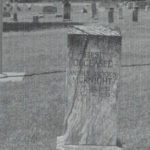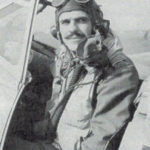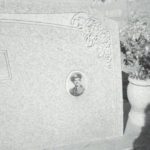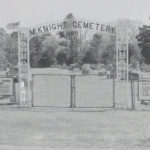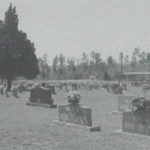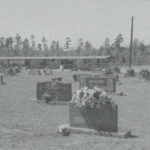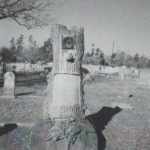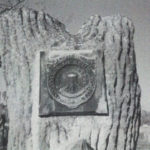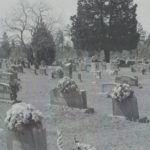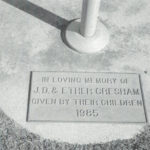McKnight Cemetery History
(Nacogdoches County, TX)
1853- 2006
Download full history document by clicking here
Prior to the coming of the Texas & New Orleans Railroad (T. & N.O.) to the northwestern region of Nacogdoches County in 1903, several older, thriving communities already existed: Toliver, McKnight’s Seminary, Glenfawn and Linn Flat, for example. The closest old road in the area ran roughly northeasterly from Toliver to Linn Flat through the northwest edge of the county.
In horse and buggy days, Nacogdoches County had lots of little towns — each with a post office, a school, a church or two, a store and a gristmill, and generally, the necessities of life. One of those was Toliver on the old highway just off today’s State Highway 204, approximately halfway between what later became Cushing and Sacul.
Toliver, a town that no longer exists, had once been called Indian Creek Settlement. Apparently, the names of clusters of population changed from time to time. There is no record of how the name Toliver was chosen.
Boswell W. Pye (1833–1913) was the only postmaster Toliver ever had from May 26, 1888 to Jan. 30, 1904, according to a list of post offices in Nacogdoches County. Douglass, to the south, was a well-established population center on the stagecoach route on El Camino Real between Nacogdoches and San Antonio. Mail was carried by horseback back and forth to Toliver from Douglass. Among the first mail carriers were Henry Whitaker (1853-1927), Johnnie L. King, Albert King (1873-1923) and others.
Local historian, the late Edith May Corley nee Blackburn (1919-2001), wrote in 1985, “The Toliver Post Office served all of the area from Linn Flat to the Angelina River on the west. Mail came in from Douglass twice a week by horseback. J. D. Gresham from Sacul has talked with me several times about the town of Toliver. He remembered going with his father to the post office and being there when the mail arrived.”
She continued, “I can remember my mother [Verdahlia Blackburn nee Beck (1894-1972)] telling about going to Toliver as a small girl. She told about the Indian Creek School with benches hewed from logs that had pegs drove in them for the children to sit on.”
Boswell Pye, familiarly known as “Boss”, had the store at Toliver. He had held out for the railroad to come by his store; but it went a little to the east. This same circumstance happened to the town of Linn Flat when it too was bypassed by the new railroad.
The McKnight Seminary and Free Methodist Church community were in northwest Toliver, one mile from the post office. New Hope Baptist church and school community were in west Toliver, one mile and a half from the post office. Myrtle Springs school community was situated four miles south of the post office.
Toliver, with a three-mile radius, was peopled with about eighty families. You sort of get the atmosphere of Toliver at the turn of the 20th Century as you read along in the February 1900 “annual publication” of The Toliver Sun.6 There is no evidence that the second issue promised for Dec. 20 was ever published. At least, there is no known copy extant. The publication was a promotion for the Toliver settlement as many of the early newspapers were aimed at encouraging residents of the United States to come to Texas.
In this small publication, history records the first sketch of Toliver residents under the heading “A Short Partial History of Toliver.” James Gresham (1840-1915) who at the age of 60 said: “I came from Alabama in 1852 and settled near Glenfawn; came here in ’68, and settled part of the McKnight place near the McKnight Seminary; lived there till ’92 and then moved to the Clark place, where I live yet, have raised ten children, all living near here, six married.”
He continued, “The first person buried in the McKnight Cemetery was Baby Andrew J. McKnight; next was Martha Filby; next was Mr. Bullock.”
Thus, we have the first recorded mention of the McKnight Cemetery. We also learn that Indian Creek Church, the forerunner of McKnight Seminary, was organized in 1850 and New Hope Church about 1852. Sometime after 1870 Henry Clay Fuller (1841-1895) became a school teacher at the Indian Creek School near Toliver.7 The Fullers had immigrated to Texas while it was still a Republic offering land grants.
We know now that McKnight Cemetery began as a family burial plot in August 1853 with the burial of Andrew Jackson McKnight, the small son of William and Rebecca McKnight. William and Rebecca are each listed in the Nacogdoches County TX 1850 Federal Census at a time when Texas was still the Republic of Texas.
Little is known about this family except that William Newton McKnight was born August 31, 1809 in South Carolina and died March 14, 1855 in Nacogdoches County, Texas. He married Rebecca Fail on December 23, 1830. She was born December 23, 1810 and died September 15, 1863. William was buried in 1855 and Rebecca Fail McKnight was buried in 1863 on either side of their son Andrew. There had been no monument for young Andrew until caring citizens later erected the marker, which stands today where the grave was believed to lie.
According to Deed dated June 22, 1854-55 recorded in Record L, pages 246-247 of Nacogdoches County, William McKnight had acquired a 312 acre parcel measured in the Spanish varas patented May 13, 1854 from Allen J. Fuller on which the graves were located. It was common for family burial plots to emerge around the countryside on their own farmland.
Thereafter, McKnight soon evolved into a community burial plot with the addition of other families such as Perry, Rawlinson, Gilhouly, Chancellor, Fuller, Thomas, Blackburn, Rogers, Birdwell, Durrett, Lloyd, Whitaker, Kinney, King, Lyles, Gresham, Beck, Matteson, Benison, Pitman, Pye, Wade, Barton, and Mason, all before 1900.
Along with other such families, the Chancellors first came to Nacogdoches County about 1848 from Autauga County, Alabama. Moses Chancellor was born in 1795 in South Carolina and died in 1865 in Texas. It was reported in 1975 that he and four generation of Chancellors are buried in McKnight. In 1985, it was reported that there were seven generations of Chancellors buried at McKnight.
The Chancellor and Lloyd burial sites still have the period iron fencing surrounding original gravestones. Other family sites have concrete borders surrounding the graves with engraved family names set in the borders.
Recognizing the need for a building in which to hold funerals, the community erected one in the 1870’s to serve as a meeting house, a place for worship, and a seminary to train its students in the Gospel as well as provide an education for its children. It was called McKnight Seminary because it was located on land donated by the William Newton McKnight (1809-1855) family on the west side of the road across from the present church building.



